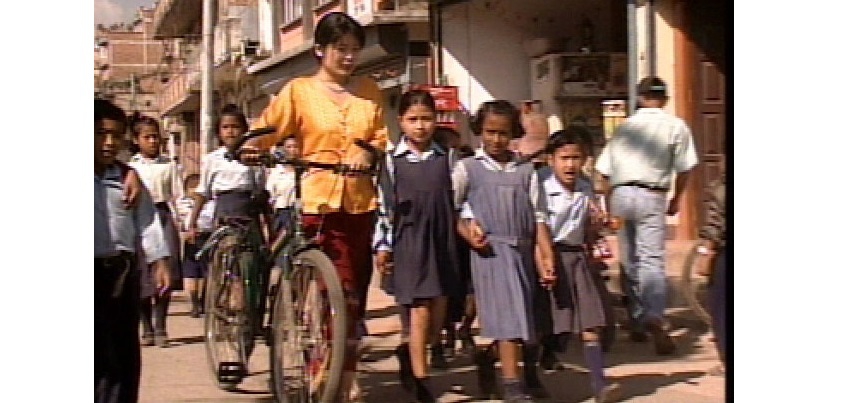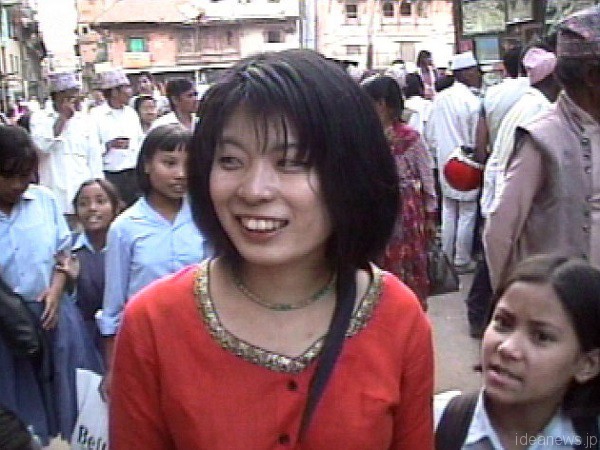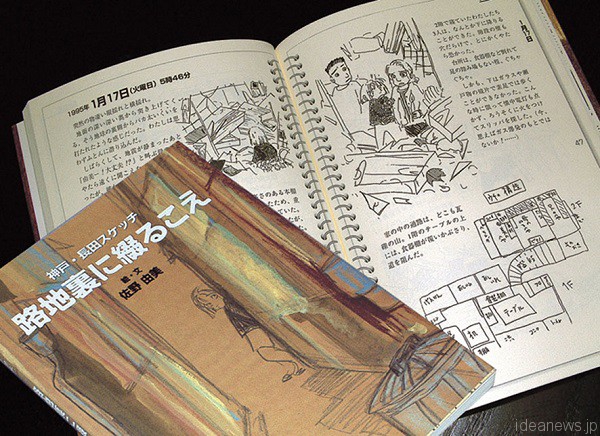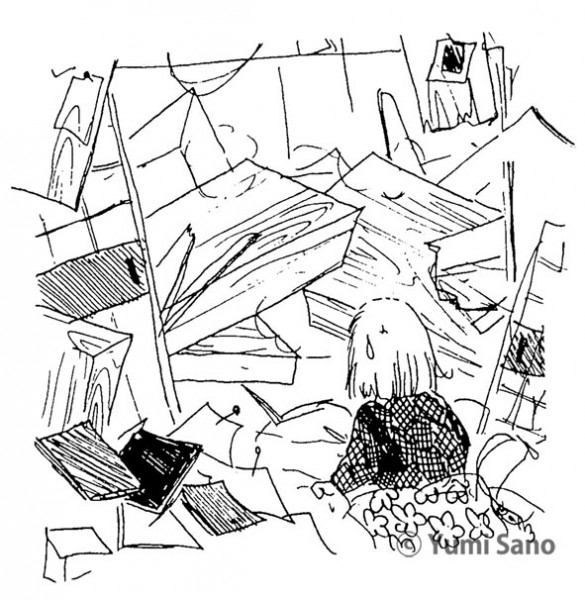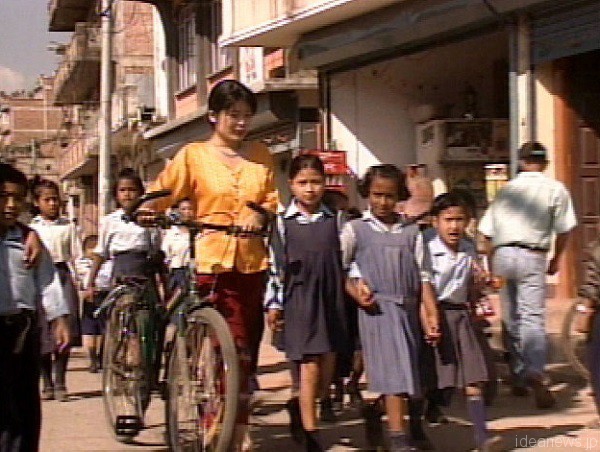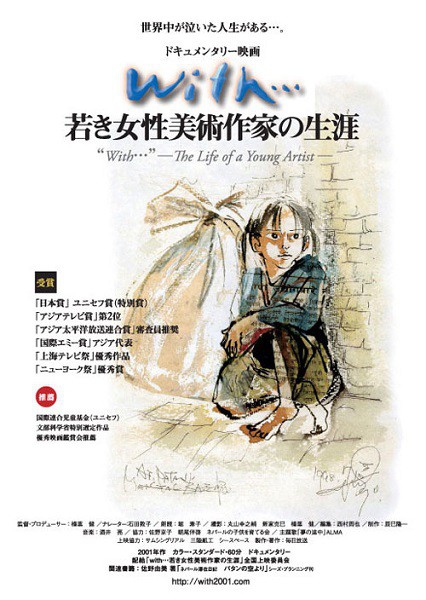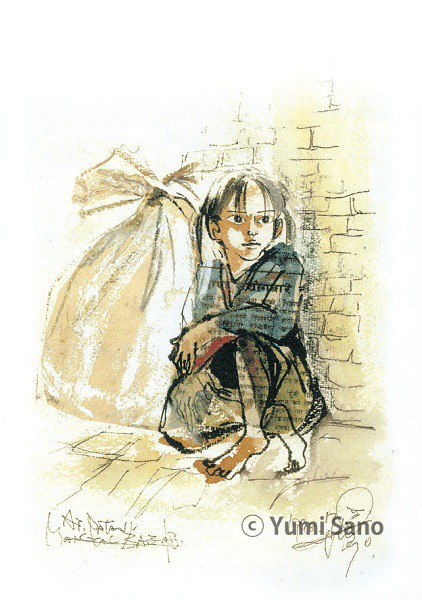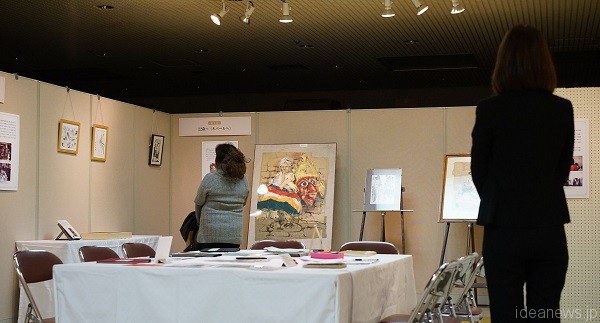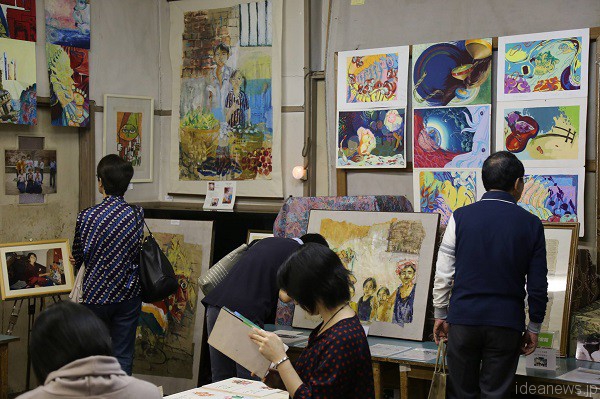6回にわたってアイデアニュースに連載した桝郷春美さんの記事「映画『with…若き女性美術作家の生涯』が生み出したもの」について、英語圏および英語がわかる方々にも読んでいただくため、桝郷さんが連載を英語でまとめた記事を書かれましたので、全文英語で掲載します。有料会員向け部分には日本語の「連載のあとがき」を掲載しています。なお、アイデアニュースでは、ただいま「おためし初月無料キャンペーン」を実施していますので、有料会員登録しても月内に退会すればお金は一切かかりません。ぜひおためしください(→https://ideanews.jp/backup/archives/2387)(アイデアニュース編集部)。
———————————
By Harumi MASUGO
This article is to introduce a documentary film about the life work of a young artist named Yumi Sano. Titled; “with…The Life of a Young Artist”, it was released in 2001. Since then it has been screened independently in various parts of Japan. To this day the non-fiction story has been viewed by many people who are still deeply inspired by Sano’s life. Originating from a TV documentary series by Mainichi Broadcasting System, Inc., which told the stories of people who survived from the devastating 1995 Great Hanshin-Awaji Earthquake, and turned their hardship into energy of lives.
Her name is Yumi Sano. Born in Nagata-ward, Kobe in 1975, she survived the 1995 Great Hanshin-Awaji Earthquake. At the time, she was a student at Osaka University of Arts majoring in Fine Arts. Her hometown had been badly afflicted by the disaster and her house had been destroyed. After facing a life-and-death struggle, she couldn’t find any meaning in her art. Yet she could not help but sketching the confronting reality that she faced. She made real-time sketches of the scenes and local people three days after the earthquake. Her sketches have been published with her essay Rojiura ni tsuzuru koe: Kobe-Nagata sketch (by Rokko Shuppan, 1998/reprinted by KUTOUTEN Co. Ltd., 2014) that became a bestseller in Kobe.
“Being alive was what I could only obtain after the lives of thousands were mercilessly cut short following the disaster. That was the fundamental at least to feel happiness”, Yumi wrote in the book as a survivor’s viewpoint. Experiencing the process of recovery was a galvanizing experience. She regards “alive” as zero point, which means the starting point of living. Going through the process of regaining access to water and foods, having secured space to sleep, keeping a warm, and recovering electricity was like living a very condensed history of civilization. She lost many things materially, but she gained a new perspective both on life and on the creation of her art; she has begun finding more value in “reality”.
She received a first-class honor when she graduated from university, which she concluded was a success only relative to her particular environment. She was driven to challenge whether her successes meant anything in another part of the world: For her that meant living in a developing country. So she decided to spend a year in Nepal. She had previously visited Nepal for three weeks to do some volunteering at an orphanage when she was a student and she always wanted to return. This time not merely as a visitor but as someone who actually lived there. In other words, by living there she wanted to see what the “reality” looked like. With such a strong will in mind, she actively immersed herself in the native culture and associated with local people. She learned not only Nepali, but also local ethnic language Newari, to better her understanding of the land. “I wanted to live here, to assimilate myself with these people and adapt to their lifestyle. The reason is, unless you do so, you can’t really understand these people. Because when I gain that understanding, I will have things to draw”, Yumi said in the interview for the film “with…The Life of a Young Artist” shot in Nepal.
For her one-year stay she chose Lalit welfare elementary school, located in slum of the Patan-city. She spent precious time with children and thoroughly love them. Actually, most of the children live in very difficult and confronting circumstances. This forced her to face the serious social issues such as poverty and the discrimination underlying the caste system.
As an art teacher, her first ambition was to teach children about the joy of creation and expression. She believes that it gives energy to enrich and broaden their souls. She taught her students paper craft for joy at first. But as she realize more about their circumstances, her teaching eventually shifted to teach more technical skills with the hope that they will be able to acquire the skills to develop careers in the future.
As an artist, she made over 53 paintings, drawings, and sketches. She kept 25 sketchbooks. Her art is focused on human particularly living in severe hardship of the “reality” meeting what she realized was a true sense of living. And she shed light on the inner reaches of the minds of the human through art.
The camera had followed her life for 3 years from Kobe to Nepal. This documentary received many international awards, such as the UNICEF prize of the JAPAN PRIZE International Contest for Educational Media in 2000, Runner Up as Best Documentary Programme by Asian Television Awards in 2000, and many more. Takeshi Shiba, director and producer of the documentary was determined to capture her story. “I cannot be over with this story just to broadcast temporary. I have a responsibility to pass this story for future by film. You will see the reason when you watch the film”, Shiba said.
This is not a commercial film and nor publicity at all. When it was released 14 years ago, the Internet was not yet widely used. Yet the film has been growing gradually through word of mouth and spread all over the nation, even gaining attention overseas. Including the TV series, more than 2 million people have watched Sano’s story. Currently the film is screened at schools and companies, and even independently by many people who were deeply inspired by the young artist’s life.
The film is also contributed for child education in Nepal and supported toward the restoration from the great earthquake occurred in Nepal in April 25, 2015. Since the film released in 2001, the foundation has set up and it has been supported extension of the school building at Lalit welfare elementary school, child support for Jyoti Kendra nursery school in Pokhara, and more. From May 2015, the film has been specially playing for long-run at the independent cinema gallery, Tengeki Kinematron in Osaka, Japan for supporting Nepal.
Lastly, this article introduces Yumi Sano’s art. Nepali visual artist, Erina Tamrakar who has known Yumi for about 20 years said that “The language of color and canvas made us share our feelings together and bond with each other through art.” “I found that she was one of the few foreign artists struggling in Nepal who was talented and dedicated.”
Above all, her ambition to really associate with art is to presenting the “reality” that she found in Patan, Nepal, to the wider world with hope. When she held a solo show in Nepal, the local newspaper reviewed as follows: “Shopkeeper, barber, hawker, pilgrims, housewives or simply children on the street—all have added novel colours in her creations.” (Razen Manandhar, Yumi Sano’s Nepal on paper, The Kathmandu Post, March 14, 1999, at 8/SP)
There is a painting of a bare-footed girl that was Yumi’s favorite one. At first, she had no intension to sell it, but a woman asked to purchase it. The woman who bought it has worked in the Regional Office for South Asia of UNICEF at that time. She shared her thoughts about the painting in the interview for the film as follows: “This one somehow reminds me all those children in Nepal, particularly children in difficult circumstances. It (the drawing) will go around the world with me now.” ”…It reminds me of what UNICEF doing, trying to help all those children around the world.”
Although she once felt hopeless about what meaning art can have after devastating loss, she regained her passion for art by pursuing the “reality”. The young artist’s spirit is brought alive through screen. Her art affect people’s hearts warmly, peacefully, and heart aching even.
———————————
“with…The Life of a Young Artist” Special Road Show to support Nepal from 2015 Earthquake
Place: The independent cinema gallery, Tengeki Kinematron
Address: 1-1-18 Nakazaki-Nishi, Kita-ku, Osaka, Japan
Tel: 06-6371-5840 (Cafe AMANTO)
Email: with☆amanto.jp (change the mark ☆ to @, when emailing.)
How to apply: If you gather at least 4 people, you can request your desired date and time between 11:30 a.m. to 10:00 p.m. upon request. 25 people maximum.
Fee: 1500 JPY and donation to Nepal
All income and donation will be contributed to the reconstruction of the school located mountain area in Gorkha District, Nepal.
Yumi SANO exhibition “Gallery with”
Place: Nagata Church in Kobe
Address: 4-8-2, Hasumiya-dori, Nagata-ku, Kobe, Japan
Reservation is required. Please call for appointment 078-691-0527
———————————
By Harumi MASUGO
Freelance writer. When she lived in Seattle, U.S., she founded her great-grandfather’s diaries that he kept writing for 60 years of his living in U.S. and Japan. Discovering the unknown history through diaries made her to be a writer and specializes in non-fiction writing. She worked on the editorial staff on Asahi.com., and assumed her present post.
———————————
アイデアニュースは、読者に本当に役に立つ情報を提供するため、企業広告を一切掲載せず、記事のようでじつは企業からお金をもらっている「タイアップ記事」も掲載せず、有料会員のみなさんの支援のみで運営しています。ほとんどの記事には有料会員向け部分があり、「全文閲覧権」(月額300円、初月無料)を購入すると、過去の記事を含めて、すべてのコンテンツの全文が読めるようになります。良質な取材活動を続けるため、どうかご協力をお願いいたします。全文閲覧権購入の検討は、こちら ⇒https://ideanews.jp/backup/archives/2387
<アイデアニュース有料会員向けコンテンツ>
6回にわたった連載と英語版についての「あとがき」を掲載しています。
「映画『with…若き女性美術作家の生涯』が生み出したもの」の連載の終わりに、英語の記事を書きました。タイトルは「神戸から世界へ――若き美術作家が追い求めた“リアリティ”」。
佐野由美さんがネパールで見つめた「リアリティ」とは、どのようなものだったのか。書くことを通して見つめたいと思いながら、最後の英語の記事を書きました。
その過程で、由美さんの手書きの文章に出会いました。そこに由美さんが震災を経験して「あれ以来、私はリアリティというものを凄く大切にするように」なったという一文を見つけました。阪神・淡路大震災が起きてから、3カ月ほど経った1995年5月2日に由美さんが記した文章で、『震災と美術をめぐる20の話――1月17日を通過して』(ギャラリー ラ・フェニーチェ、1995.9)とういう本の付録で紹介されていたものです。
そしてもう一つ、印象に残っているのが「『生きていること』がゼロ地点だった」という言葉。『神戸・長田スケッチ 路地裏に綴るこえ』で、由美さんが書いたエッセイの一文です。その後には、「たくさんの方が亡くなられた震災時、『生きていること』が幸福の第一条件だった」と続きます。
「生きていること」をゼロ地点ととらえる感覚、震災を経験して、リアリティを大切にするようになったこと。この2つが、由美さんの表現を見つめるうえで、 とても気になっていました。同じ体験をしていない私が、由美さんのその境地に近づくことはなかなかできないのですが、それでも気になって止まないのは、私自身が、東日本大震災以降、三陸地方や、福島県の被災地域に身を置く中で、何をどう伝えていいのかわからなくなってたじろいでしまい、もがき苦しんできたからです。
そこにある現実を知った者としての重圧がのしかかっている一方で、実際の日常生活では、自分の身を立てるだけでも精一杯で、できることしかできなくて葛藤ばかり。そんな自分が悔しくて、情けなくて、後ろめたくて。どうにもならない気の重さを抱えていました。
また、困難な状況にあっても「逆境を生きる力に変えていく」過程にいる人たちに出会ってきました。そんな人たちのことを、「震災」や「被災地」というイメージの側面からだけでは捉えたくなくて、だけど、土地の深刻な現実も実際に目の当たりにして、じゃあ、何を、どう表現するのか、今もずっとずっとあがき続けています。
そんな中で、「with…」を観て、由美さんの作品に出会い、生き方に触れてきました。そして由美さんのことをペンで書くことで、由美さんと眼差しを重ね合わせ、絵の向こうにあるリアリティを感じ、自分の中に取り込みたかった。そうすることで、伝えることの手がかりをつかみたいと、まるですがるような思いで、日本語の連載に取り組み、英語の記事を書きました。
「生きていること」を実感した1995年1月17日を起点に、リアリティを凄く大切するという価値観に目覚めた由美さん。震災やネパールの現実の中で、あがきながらも、自分のできることを精いっぱい取り組んで、そして描いた。ネパールで暮らした1年間で、53以上の絵画を制作、スケッチブックは25冊にも及んだ。彼女は美術を通して人間を描き、中でも厳しく、困難な状況にいる人の「リアリティ」を見つめた。そのリアリティとは彼女自身が、現地の暮らしに溶け込む中で実感し、おのずと磨かれた感性から生まれたもの。そうして人の本質を見つめ、作品に描くことで光を当てた。
そんな由美さんから、表現のヒントをつかみとりたかったのです。リアリティとは、目の前にある現実。近いはずなのに、それを表現しようとすると、遠くに感じてしまう。彼女の見つめる「リアリティ」とは何なのか。言語を変えて記事を書いた今も、その〈答〉を見つけ出せていません。
だから、また映画を観たくなる。「with…若き女性美術作家の生涯」は観終った後もずっと現在進行形なのです。これからも、ずっと…。
2015年11月26日 桝郷春美
———————————
<筆者プロフィール> 桝郷春美(ますごう・はるみ)福井県小浜市出身。人生の大半を米国ですごした曾祖父の日記を読んだことがきっかけでライターを志す。アサヒ・コム編集部のスタッフとして舞台ページを担当後、フリーランスのライターに。おもに人物ルポを中心に取材・執筆に取り組む。
<アイデアニュース関連記事>
映画「with…若き女性美術作家の生涯」が生み出したもの(1)
→ https://ideanews.jp/backup/archives/6182
観客が上映日時を決めるシアター、「with…」が生み出したもの(2)
→ https://ideanews.jp/backup/archives/6451
家なき地に迫る豪雨と雪、ネパールの被災地は今 「with…」連載(3)
→ https://ideanews.jp/backup/archives/7117
「立ち位置の意識」が遠くのことを身近にする 「with…」連載(4)
→ https://ideanews.jp/backup/archives/7989
映画×美術 終わらない物語がここにある… 「with…」連載(5)
→ https://ideanews.jp/backup/archives/9105
背中から伝わった生きるエネルギー 「with…」連載(最終回)
→ https://ideanews.jp/backup/archives/10147
From Kobe to the World: The “Reality” of Art that a Young Artist Pursues in Her Life
→ https://ideanews.jp/backup/archives/13012
